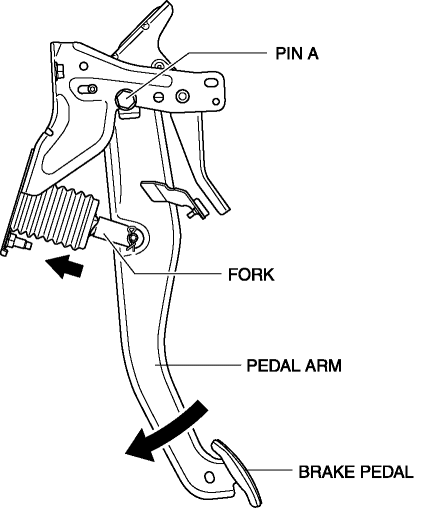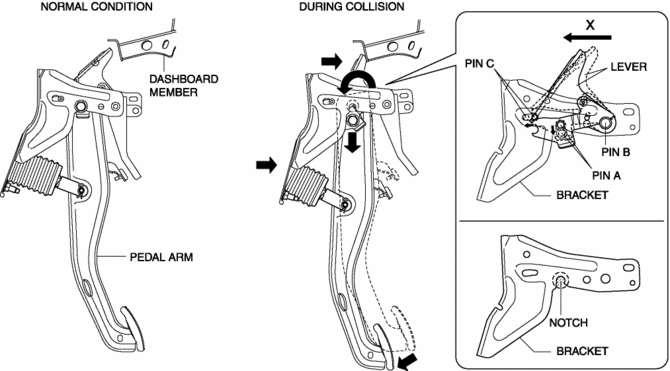Mazda CX-5 Service & Repair Manual: Brake Pedal
Purpose/Function
-
An intrusion-minimizing brake pedal has been adopted to the brake pedal to provide for a measure of safety in the event of an accident.
-
The intrusion-minimizing brake pedal mechanism reduces impact to the lower extremities of the driver by minimizing the amount of rearward brake pedal thrust in a frontal collision.
Construction
-
The intrusion minimizing brake pedal mechanism is structured on the brake pedal and consists of the following parts.
-
Pedal arm
-
Lever
-
Pin A
-
Pin B
-
Pin C
-
Bracket

Operation
During normal braking
-
When the brake pedal is depressed, the pedal arm rotates at the pin A fulcrum point, and the pedal depression force is transmitted to the fork of the power brake unit.
-
This pedal depression force pushes in the fork to operate the brakes.

Intrusion-minimizing operation
-
In a frontal collision, the brake pedal is forced rearward by the movement of the dashboard.
-
In response to this, force in the direction of X is applied to the brake pedal lever because the dashboard member and brake pedal lever interfere.
-
With the addition of force in the direction of X, pin C releases from the lever, and the lever rotates around the pin B fulcrum point.
-
When the lever rotates, it obstructs pin A at the fulcrum point of the pedal arm.
-
If the pedal rotates further, pin A separates from the bracket (notch), and the pedal is freed.
-
By freeing the pedal arm, the force applied to the lower extremities is reduced.

 Brake Hose (Rear) Removal/Installation
Brake Hose (Rear) Removal/Installation
1. Remove in the order indicated in the table.
2. Install in the reverse order of removal.
3. After installation, add brake fluid, bleed the air, and inspect for fluid
leakage..
...
 Brake Pedal Inspection
Brake Pedal Inspection
Pedal Height Inspection
1. Measure the distance from the center of the upper surface of the pedal pad
to the insulator and verify that it is as specified.
If not within the specificatio ...
Other materials:
Throttle Body
Purpose, Function
Opens/closes the throttle valve to adjust the amount of air supplied to the
cylinder.
Opens/closes the throttle valve according to the control signal from the
PCM.
Construction
The throttle body is installed to the intake manifold.
Th ...
Power Steering Malfunction Indicator Light
Purpose
The power steering malfunction indicator light warns the driver that there
is a malfunction with the electric power steering (EPS) system.
Function
If there is a malfunction in the EPS system, the power steering malfunction
indicator light illuminates.
If th ...
Generator Disassembly/Assembly [Skyactiv G 2.0]
CAUTION:
Melt the solder quickly, otherwise the diodes (rectifier) and regulator will
be damaged by excessive heat.
1. Disassemble in the order indicated in the table.
2. Assemble in the reverse order of disassembly.
1
Rotor component
...
